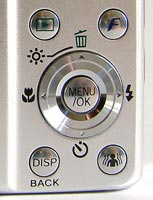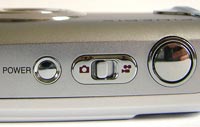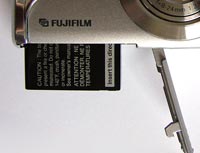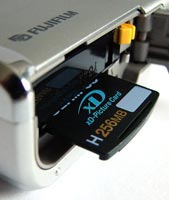Fujifilm Finepix F20 Review
Review Date: October 18th 2006
Author: Gavin Stoker
Leave a comment about this Review
|
Ease of Use
Released in the wake of the fanfare afforded its bigger brother, the ISO3200-touting Fujifilm F31fd, it would be easy to overlook the newer 6.3 megapixel F20, sporting as it does light sensitivity capped at ISO2000 plus the same-y features of a six megapixel resolution, intelligent flash and 2.5-inch LCD screen. But to simply plump for the more expensive F20 would be to do the Fujifilm F20 a disservice. A combination of responsive performance and competent features, plus a very keen price point, add up to a compact worth more than a second glance.
Like its predecessors (including the F10 and, in Europe at least, the F11), the Fujifilm Finepix F20 resembles more of a traditional snapshot, its boxy shape a contrast to the tapered or curved body designs seen on similarly pocket-sized compacts recently. With a metallic sheen to the surface of the body, build quality is reassuringly high, and, with lithium ion battery pack and xD-Picture Card inserted, the camera feels sturdy in the palm yet lightweight enough to slip unobtrusively into a trouser.
With an optical viewfinder absent the back of the Fujifilm Finepix F20 is dominated by the LCD. Top right of this is a nicely springy and responsive rocker switch for the zoom. Directly beneath sits a row of rubber dots to prevent your thumb from slipping when the camera is gripped in one hand. Just below is a familiar four-way control dial or toggle, encircling a self-explanatory menu/ok button. It must be said that the Fujifilm menus are some of the most logical and easily navigated on a digital compact. The initial ‘shooting menu’ gives access to the shooting modes, which include full auto and manual, as well as Natural Light, Natural Light & Flash, Portrait, Landscape, Sport, Night, Fireworks, Sunset, Snow, Beach, Museum, Party, Flower, Text and continuous Anti Blur (there's another dedicated button for occasional activation, more on this later).
| The Major Controls | Power Button/ Mode Switch / Shutter Button |
 |
 |
In truth, and as expected, the camera handles itself well on auto (default) setting. Scroll down to the bottom of the shooting menu and you get the set up menu. Access this and you get three folders, each containing the standard auxiliary settings you'd expect on a point and shoot, including the ability to switch the likes of the AF illuminator on/off, disable /enable the digital zoom, and more importantly format the 10MB internal memory or card in use. The same set up menus can also be recalled in playback mode.
Ranged around the above dial are a trash can icon for deleting unwanted images on the fly, which, in capture mode, doubles up as a one-touch means of boosting the LCD's brightness, plus self timer, flash and macro settings. With all Fujifilm's talk about shooting in low light with both the Fujifilm Finepix F20 and the F20, it’s easy to forget that the flash settings include slow synchronization, plus a combined slow synchro and red eye reduction setting. This again confirms the impression that this is a camera mainly for low light portraiture – doubtless for use to best effect in the party season leading up to Christmas. In terms of visibility, use of the LCD was more than acceptable both indoors and out.
Above and below the control toggle are immediately identifiable buttons for playback, plus calling up the on-screen display. As a default, the screen shows the chosen shooting mode, flash setting, battery life, resolution and image quality plus shots remaining. Press the button again and these disappear to leave a completely clean view, while a third press brings up a nine-square compositional grid. More interestingly, a fourth press reveals the ‘post shot assist’ window, which stacks up the last three captured images, one on top of the other, while leaving the majority of the screen to the right free for lining up a fourth. It's useful for an image-to-image comparison when capturing a panorama perhaps, but arguably inessential otherwise.
| Battery Compartment | Memory Card Slot |
 |
 |
Also above the four-way dial is the ‘F’ (for ‘Photo’ mode) button that will be familiar to any Fujifilm convert. In capture mode this affords rapid access to the essential triumvirate of resolution and ISO settings (ISO100 through to ISO1600 in manual mode – the boasted ISO2000 only available when selecting Natural Light shooting mode), plus colour modes. The last setting gives the choice of standard (read ‘natural’) plus black and white or chrome settings. I must admit a fondness for the latter setting, which, for me, provides shots with more of a dynamic and vivid punch than the default. Perhaps it’s because they somewhat recall the results from a cheap Lomo film camera.
The last dedicated button on the camera back is the image stabilization or anti-shake setting (here referred to as ‘anti blur’). Unlike other compacts this doesn't mean the Fujifilm Finepix F20 sports a CCD shift mechanism – nor is it an optical IS. Disappointingly it means the camera merely selects a faster shutter speed. It seems that Fujifilm is still to play catch up with the likes of Canon (the IXUS 800 IS) and Ricoh (the Caplio R5) with respect to more convincingly addressing image stabilization. That said, results argent bad, as we’ll see later.
Commendably, the Fujifilm Finepix F20’s controls buck the trend for buttons so small that you need a toothpick to operate them. Being neither too small nor too large, they feel ‘just right’ in relation to the overall dimensions of the camera. And, in the heat of the moment, all can be ergonomically accessed with use of just the thumb or forefinger.
Atop the Fujifilm Finepix F20 are the obvious shutter button, a slider for switching between stills and video capture, plus the slightly recessed power on/off button. Press this and the LCD blinks into life, the lens barrel extending to maximum wide angle ready for the first shot. Total time: just over a second. Any shutter delay is slight, while there's a two-second wait while maximum resolution JPEGs are committed to memory. Overall the camera feels responsive, even if those times are pretty average for its group. Also average is its battery life at 300 shots from a single charge, though pleasingly it was still indicating full power after a five-day trip.
Overall, the Fujifilm Finepix F20’s performance impresses, with no obvious operational quirks or deficiencies in build to put off potential investors.
|
![]() PhotographyBLOG
is a member of the DIWA
organisation. Our test results for the Fujifilm Finepix F20
have been submitted to DIWA
for comparison with test results for different samples of
the same camera model supplied by other DIWA
member sites.
PhotographyBLOG
is a member of the DIWA
organisation. Our test results for the Fujifilm Finepix F20
have been submitted to DIWA
for comparison with test results for different samples of
the same camera model supplied by other DIWA
member sites.
